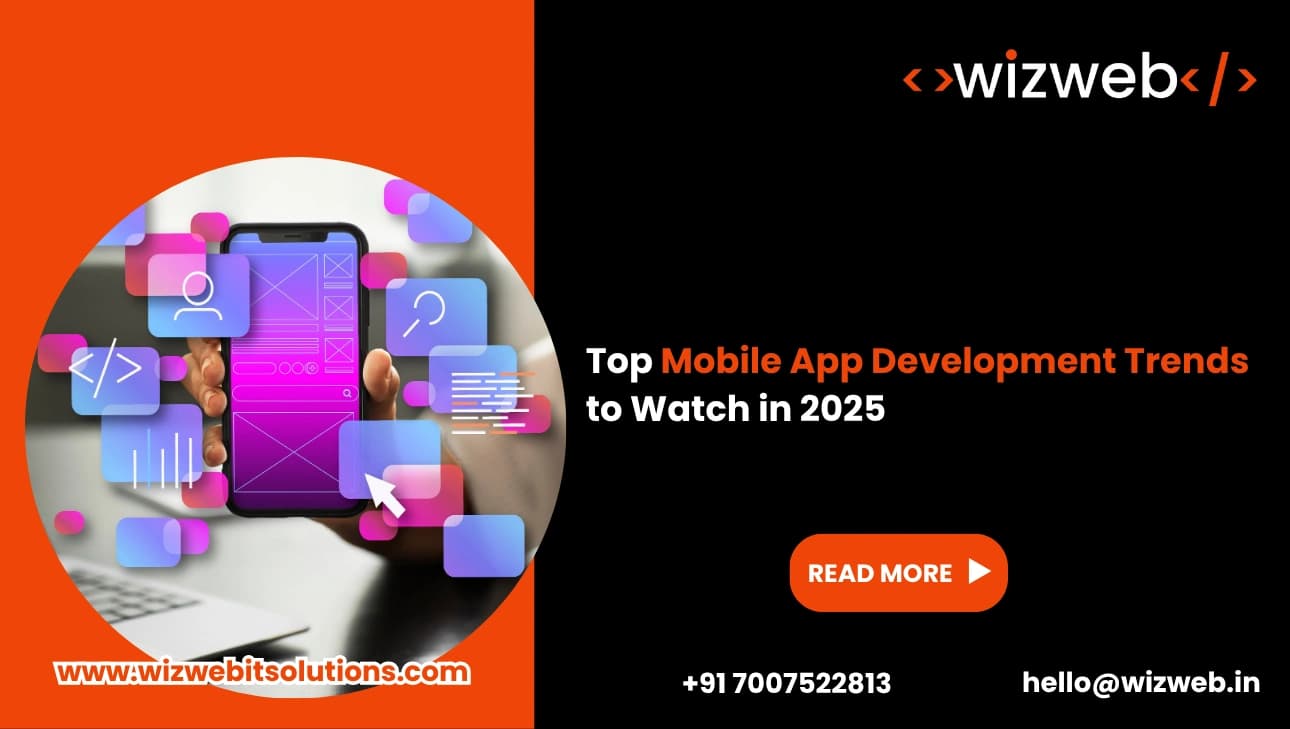Get in Touch
- Phone
+91 700 752 2813
- Email Now
hello@wizweb.in
Office No - 204 A-140, Sector 63 Road Noida, Uttar Pradesh 201301

The world of mobile apps changes fast. Every year, we see new features, better designs, and smarter technology. In 2025, the changes are bigger than ever. If you have a business, an app idea, or you simply love technology, knowing the Mobile App Development Trends will help you stay ahead.
In this blog, we’ll look at the most important trends for 2025. We’ll explain them in simple words so you understand how they work, why they matter, and how they are shaping the future of apps. By the end, you’ll know exactly what’s happening in the world of mobile apps and how Mobile App Development Services are adapting to these trends.
One of the biggest Mobile App Development Trends in 2025 is the use of artificial intelligence (AI) inside apps. AI is not just for big tech companies anymore—it’s becoming part of everyday mobile apps. For example:
In 2024, AI-powered apps saw billions of downloads. People love apps that can “think” and make life easier. Mobile App Development Services now often include AI integration because it makes apps more powerful and more useful.
Not everyone knows how to code, but what if you could just tell an AI what you want your app to do and it creates the code for you? That’s what vibe coding is about. It’s one of the most exciting Mobile App Development Trends for developers and non-developers alike.
With vibe coding, you describe your app in plain English, and AI writes the code. Then, you or your developer can make small changes to make it perfect. This means apps can be built faster, and more people can bring their ideas to life without needing years of coding experience.
AI in apps is amazing, but sometimes it’s slow because the app has to send data to a server and wait for a reply. In 2025, phones are becoming powerful enough to run AI directly on the device. This means:
This is a big step for Mobile App Development Trends because it gives users smoother and more private experiences. Mobile App Development Services are now focusing on making apps smarter without depending too much on cloud services.
Designing an app usually takes a lot of time—planning the look, making the screens, and writing the code. But now, AI tools like Stitch are changing that. You can describe your app’s look or upload a sketch, and the tool creates ready-to-use screens and code.
There’s also Declarative UI generation, where AI takes your design ideas and turns them into real, working app code. These tools are saving developers hours of work, making them a key part of Mobile App Development Services.
The way we use apps is also changing because of new devices and faster networks:
These Mobile App Development Trends are making apps more interactive and fun to use. Businesses working with Mobile App Development Services now have to design for all these new technologies.
In 2025, users expect apps to feel personal. This means apps should:
For example, a fitness app might suggest a workout when it sees you haven’t exercised in a few days. A shopping app might remind you about something you looked at last week. This kind of personalization is one of the Mobile App Development Trends that keeps users engaged.
Our phones are no longer just for calling or browsing. They control smart homes, cars, wearables, and even appliances. This is where the Internet of Things (IoT) comes in.
Imagine using your phone to:
Mobile App Development Services are now including IoT features in apps to make life more connected and convenient.
PWAs are like a mix between a website and a mobile app. They work in your browser but feel like a native app. They are fast, take up less space, and don’t need app store downloads. Businesses love them because they are cheaper to develop and update.
This is another area where Mobile App Development Trends are focusing—making apps accessible without forcing users to download heavy files.
These Mobile App Development Trends are not just “cool tech.” They change the way we live, work, and interact with our devices. For businesses, they mean better customer engagement and more opportunities to offer useful, modern solutions.
If you’re thinking about creating an app, choosing Mobile App Development Services that understand and use these trends can help you stay ahead of competitors. They can make sure your app is not only functional but also future-proof.
2025 is shaping up to be an exciting year for mobile apps. With AI, faster networks, new devices, and better design tools, we’re moving toward apps that are smarter, faster, and more personal. By understanding these Mobile App Development Trends, you can make better choices—whether you’re building an app for your business or simply curious about the future.
If you want your app idea to match these trends, work with Mobile App Development Services that keep up with technology and know how to turn these innovations into real, user-friendly experiences. The future of mobile apps is here, and it’s full of possibilities.